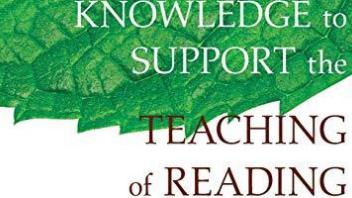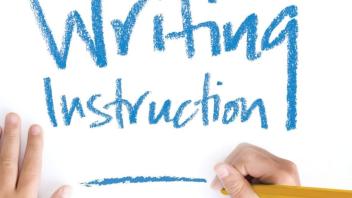Featured booklists
Themed Booklist
Teaching Reading
Themed Booklist
The Cognitive Science of Reading
Themed Booklist
Reading Motivation and Reading Aloud
Themed Booklist
Teaching Writing
Themed Booklist
Learning Differences
Themed Booklist
In the Classroom: Teaching Children on the Autism Spectrum
Themed Booklist
About Autism: Books for Parents and Educators
Adult Education Books
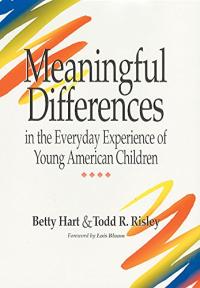
Meaningful Differences in the Everyday Experience of Young American Children is the landmark research study that uncovered the widely cited “word gap” between children from low-income homes and their more economically advantaged peers. For 2-1/2 years, Haet and Risley recorded every word spoken at home between parent and child in 42 families, categorized as professional, working class, or welfare families. Between professional and welfare parents, there was a difference of almost 300 words spoken per hour. Extrapolating this verbal interaction to four years, a child in a professional family would accumulate experience with almost 45 million words, while an average child in a welfare family would hear just 13 million — coining the phrase “the 30 million word gap.” Hart and Risley’s follow-up studies at age 9 show that the large differences in children’s language experience were tightly linked to large differences in child outcomes. By giving children positive interactions and experiences with adults who take the time to teach vocabulary, oral language concepts, and emergent literacy concepts, children should have a better chance to succeed at school and in the workplace.
Meaningful Differences in the Everyday Experience of Young American Children

This companion to the award-winning Meaningful Differences in the Everyday Experience of Young American Children reveals how daily child-parent social interactions govern children’s language and social development. Based on data from 2-1/2 years of observing the everyday interactions of 1- and 2-year-old children learning to talk in their own homes, Hart and Risley have charted the month-by-month growth of the children’s vocabulary, utterances, and use of grammatical structures. The narrative highlights reliability-tested research findings and is supplemented with numerous transcripts from observations and a list of 2,000 words of children’s expressive vocabulary from 19-36 months of age.This book is must-reading for professionals in speech and language, child development, psychology, and education who need to understand how children come to talk as much and as well as their parents and caregivers.
The Social World of Children Learning to Talk

Children, Schools, and Inequality examines elementary school outcomes in light of the socioeconomic variation in schools and neighborhoods, the organizational patterns across elementary schools, and the ways in which family structure intersects with children’s school performance. Adding data from the Baltimore Beginning School Study to information culled from the fields of sociology, child development, and education, this book suggests why the gap between the school achievement of poor children and those who are better off has been so difficult to close. The authors show why the first-grade transition — how children negotiate entry into full-time schooling — is a crucial period. This book can inform educators, practitioners, and policymakers, as well as researchers in the sociology of education and child development.
Children, Schools, and Inequality

Making the Most of Summer is a resource for providers who want to improve the quality of their summer programs by meeting the academic and youth development needs of their participants. The handbook contains a variety of easy-to-use planning tools designed to help summer programs be able to do the following: (1) incorporate the characteristics of effective summer learning programs; (2) implement engaging thematic units that meet challenging academic and youth development standards; (3) improve the quality of summer staff development opportunities; and (4) evaluate the success of their programs and services; and e) develop a long-term strategy for sustaining their work.
Making the Most of Summer: A Handbook of Effective Summer Programming and Thematic Learning

Comprehensive and authoritative, this forward-thinking book reviews the breadth of current knowledge about early education and identifies important priorities for practice and policy. Robert C. Pianta and his associates bring together foremost experts to examine what works in promoting all children’s school readiness and social-emotional development in preschool and the primary grades. Exemplary programs, instructional practices, and professional development initiatives — and the systems needed to put them into place — are described. The volume presents cutting-edge findings on the family and social context of early education and explores ways to strengthen collaboration between professionals and parents.
Handbook of Early Childhood Education
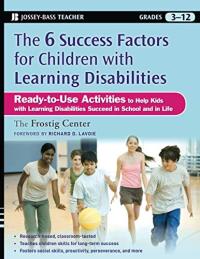
This book identifies the six attributes that lead to success for children with learning disabilities — self-awareness, proactivity, perseverance, goal-setting, social support systems, and emotional coping strategies — and presents structured activities that foster those traits in students. Each of the 60 fun, ready-to-use activities contains a lesson plan and reproducible student worksheet, complete with modifications, accommodations, and helpful teaching tips.
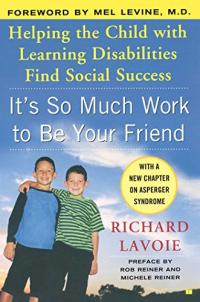
“Life without friends is a lonely and barren existence,” but that’s a common fate for children who fail to develop proper social skills, writes veteran special education teacher Lavoie in his insightful guidebook to helping children with learning disabilities overcome social skill deficits. Eschewing sink-or-swim and carrot-and-stick approaches, Lavoie stresses communication and patience for parents looking to guide their children through the maze of social interactions encountered daily, from arranging successful play dates and navigating the hidden curriculum of school, to language difficulties, social anxieties and family issues. Lavoie, who has taught and worked in the special education field for over 30 years, shows how to detect learning disabilities, discusses their impact on a child’s social development and provides strategies for implementing behavior change.
It’s So Much Work to Be Your Friend: Helping the Child with Learning Disabilities Find Social Success
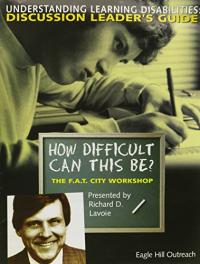
This book is the leader’s discussion guide for the F.A.T. City Workshop (opens in a new window). This important program looks at the world through the eyes of a learning-disabled child by taking you to a unique workshop attended by parents, educators, psychologists and social workers. There they join in a series of classroom activities which, cause frustration, anxiety and tension — emotions all too familiar to the student with a learning disability.
How Difficult Can This Be? The F.A.T. City Workshop
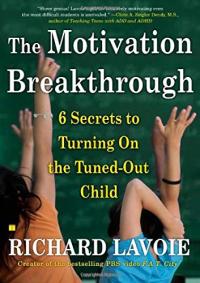
Backed by decades of experience in the classroom, Lavoie explodes common myths and gives specific advice for motivating children with learning disabilities. He outlines parents’ and teachers’ roles, suggesting ways in which they can work together to encourage any child to reach his or her potential. Finally, he reveals what we can learn from some of the most powerful motivators in the world: advertisers. With empathy and understanding, Lavoie offers parents and teachers the key to unlocking enthusiasm and responsiveness, proving any child can be motivated to learn.
The Motivation Breakthrough: 6 Secrets to Turning On the Tuned-Out Child

Learn what young children can do as competent, confident writers when we create writing classrooms that support their developmental patterns and provide them with multiple opportunities to write for numerous purposes across the curriculum. The authors spotlight the children’s strengths in brief case studies to help you understand the significance of their efforts, and offer specific recommendations you can use to help your own students use writing as a meaning-making tool in various subject areas and settings.
The PreK-2 Writing Classroom: Growing Confident Writers

Writing Across the Curriculum: A Critical Sourcebook

An indispensable teacher resource and course text, this book presents evidence-based practices for helping all K-12 students develop their skills as writers. Every chapter draws clear connections to the Common Core State Standards. Leading authorities describe how to teach the skills and strategies that students need to plan, draft, evaluate, and revise multiple types of texts. Also addressed are ways for teachers to integrate technology into the writing program, use assessment to inform instruction, teach writing in the content areas, and tailor instruction for English language learners and struggling writers. Helpful case examples are featured throughout.
Best Practices in Writing Instruction, Second Edition

Encouraging kids to talk about their favorite books is a powerful learning tool that can motivate and inspire. This book helps educators and parents navigate the world of children’s literature. This comprehensive, multicultural, annotated booklist is organized around themes germane to a children’s world. Teachers will find suggestions on how to integrate these books into their curriculum. Parents can use the books as a suggested reading list to foster lively discussion and self-exploration among their young readers. Whether at home or in the classroom, it’s easy to stir up a buzz about books!
Books Your Kids Will Talk About!
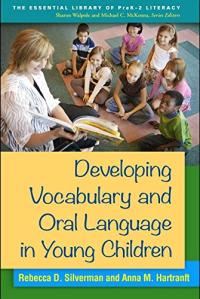
This book presents the most effective instructional strategies for promoting vocabulary growth in the early grades, when the interdependence of word learning and oral language development is especially strong. The authors guide teachers in choosing the best materials and in fostering home-school connections, and share six key principles for building vocabulary. Included are guiding questions; text boxes connecting vocabulary to the Common Core State Standards; examples from real teachers; reproducible checklists, rubrics, and other tools; and an appendix of additional vocabulary resources.
Developing Vocabulary and Oral Language in Young Children (The Essential Library of Prek-2 Literacy)

The authors — leading experts in neuropsychology and special education — present a unique model of learning disabilities that integrates the cognitive, neural, genetic, and contextual factors associated with these disorders. The volume addresses classification, assessment, and intervention for a range of disabilities involved in reading, mathematics, and written expression. With a focus on exploring the evolving scientific base of the field, as well as establishing effective educational practices, this book will serve as an essential text and an indispensable resource for school psychologists, neuropsychologists, special educators, and others who work with struggling learners.
Learning Disabilities: From Identification to Intervention

Through the eyes of parents and educators who have succeeded in their own struggles to change the educational system, the book provides the reader with the tools and knowledge for transforming the way reading is taught in their children’s classrooms. This book takes the reader step-by-step through an understanding of the research on reading and ways in which a single, determined person can make a difference in the learning ability of every student in our nation’s schools. Part One is a series of chapters written by individuals who discuss what they experienced during these battles and what made them successful. Part Two is written by a series of experts who describe how they have overcome the challenges involved in creating widespread change in school systems. The appendix is filled with resources — people, places, sample tools, a glossary, and bibliography to help the reader.
Why Kids Can’t Read: Challenging the Status Quo in Education

“Human beings were never born to read,” writes Tufts University cognitive neuroscientist and child development expert Maryanne Wolf. Reading is a human invention that reflects how the brain rearranges itself to learn something new. In this provocative book, Wolf chronicles the remarkable journey of the reading brain not only over the past five thousand years, since writing began, but also over the course of a single child’s life, showing in the process why children with dyslexia have reading difficulties and singular gifts.
Proust and the Squid: The Story and Science of the Reading Brain

The book showcases the authors guidance for administrators, teachers, parents, and concerned citizens about how best to serve the literacy needs of students of color. Hunter addresses twelve pivotal understandings and practices that encourage successful reading — from reading comprehension to Response to Intervention to oral language development and family involvement — that every educator who works with a diverse student population should understand. As Ms. Hunter maintains, “Reading is a civil right.”
It’s Not Complicated! What I Know for Sure About Helping Our Students of Color Become Successful Readers
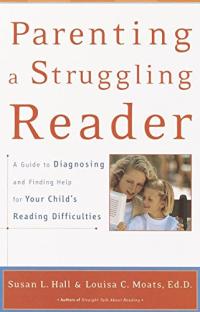
A comprehensive, practical guide for recognizing, diagnosing, and overcoming any childhood reading difficulty. Provides a four-step plan for identifying and resolving deficiencies, as well as advice for those whose kids received weak instruction during the crucial early years,
Parenting a Struggling Reader
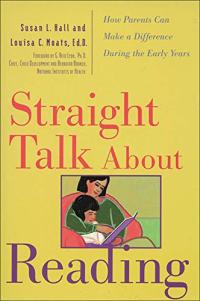
Today’s parents are increasingly concerned about the reading and spelling skills taught in schools and are taking charge of their children’s education. Full of ideas and suggestions — from innovative preschool exercises to techniques that older children can use to increase reading speed and comprehension — Straight Talk About Reading will instantly help any parent lay a solid foundation for their child’s formative educational years.
Straight Talk About Reading: How Parents Can Make a Difference During the Early Years
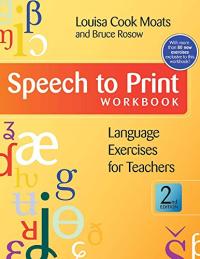
Instructors who use Speech to Print in teacher education courses now have a companion workbook for their students. This engaging, interactive workbook has an easy-to-use format and contains all the exercises in Speech to Print, plus bonus exercises, tables, and new consonant and vowel cards. Exercises include fill-in-the-blanks, multiple choice, matching activities, and transcription. Use this workbook to learn to recognize and understand the problems with language children may encounter, and discover strategies for teaching children reading, writing, speaking, and listening skills.
Speech to Print Workbook: Language Exercises for Teachers, Second Edition

Module 2 of LETRS: Language Essentials for Teachers of Reading and Spelling, this book introduces phonemes (speech sounds) and discusses the importance of phonological awareness in reading and spelling instruction. Module 2 also discusses the features of consonants and vowels and covers some of the problems that children who speak other languages or dialects may have when learning English.
The Speech sounds of English: Phonetics, Phonology, and Phoneme Awareness

Based on survey responses from over 900 adult readers and classroom feedback, Reading in the Wild offers solid advice and strategies on how to develop, encourage and assess key lifelong reading habits, including dedicating time for reading, planning for future reading, and defining oneself as a reader. Includes advice for supporting the love of reading by explicitly teaching lifelong reading habits. Contains accessible strategies, ideas, tips, lesson plans and management tools along with lists of recommended books.
Reading in the Wild: The Book Whisperer’s Keys to Cultivating Lifelong Reading Habits
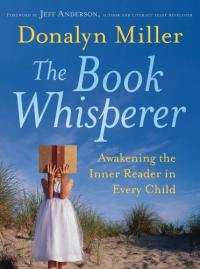
Miller takes us inside her sixth grade classroom to reveal the secrets of her powerful but unusual instructional approach. Rejecting book reports, comprehension worksheets, and other aspects of conventional instruction, Miller embraces giving students an individual choice in what they read, combined with a program for independent reading. She also focuses on building a classroom library of high-interest books, and above all on modeling appropriate and authentic reading behaviors.

